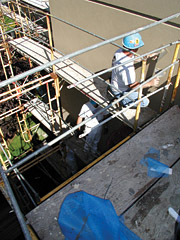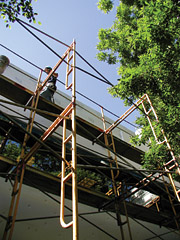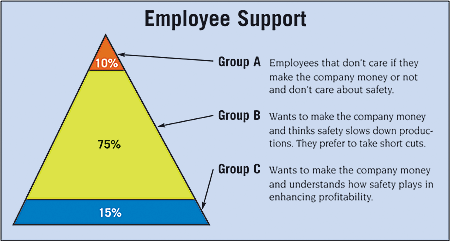

Through the use of charts, media, oration and actual safety gear, the goal is to get workers in the habit of OSHA- and state-compliant safety practices¿not out of consideration for safety- compliant issues or penalties, but to instill life saving habits that eliminate job-site injuries. Taylor¿s acronym SAFETY is a hierarchy of rules and education.
¿ Solutions
¿ Accident and comp reduction
¿ Fine reduction
¿ Employee and employer support
¿ Training
¿ Yearly company savings
Create a program
Following Taylor¿s SAFETY paradigm, ¿Solutions¿ is the trial and error; the variables that through several testing methods confirm a science that works for the program. These solutions come in concepts, plans and material.
¿In 2000, we had a high increase of cuts,¿ says Taylor. ¿So, we started looking at the process of what they were doing. The last option in safety is always personal protective wear. We tried cut-resistant gloves and they worked. Last year, we went from eight cuts a year to two cuts, and this year zero in June. We let the guys decide what they like though. If they don¿t like the product, we try something new.
¿Throughout the year, we keep an eye out to see where our injuries are coming from he continues. Our safety program is designed to prevent people from getting hurt¿it¿s not to keep us out of OSHA violations.¿
Accident and compensation reduction: As the story of the cut-resistant protective wear illustrates, patterns can be found in frequent injuries. Tracing the cause and effect of these injuries can be a long and winding narrative but generally, solutions can be found to prevent job site accidents, thus reducing the amount of money spent on ER and clinic visits. Safety instructors should keep a thorough log of all accidents and study them for patterns and like injuries. Narrowing down problems will eliminate costly hospital visits, treatment and compensation rates.
Fine reduction: Whenever an accident occurs, several trickle-down blockades present themselves, and a necessary visit from OSHA can be as costly as any injury. When inspecting an accident, and job site citations are unveiled, the hammer comes down with pricey violations issued by the organization. But whenever a visit from OSHA is inevitable, take a positive and welcoming stance: It cannot hurt matters any further.
¿We don¿t have anything to hide,¿ says Taylor, answering the question how he feels when OSHA makes a job-site appearance. ¿As a matter of fact, after an OSHA violation, nine times out of 10, I learn something from it. I learn a different rule I didn¿t know before. I don¿t know them all by heart. It¿s like asking someone out there if he knows all of Webster¿s dictionary¿well, someone out there does! But the majority of people don¿t.¿
Employee and employer support: As Taylor likes to say, it¿s not him as the safety director that makes OCP¿s safety program successful¿it¿s the company¿s president, Matthew Townsend, and the guys on the job sites. A safety program could have the best-written documents outlining all syllabi but it¿s only as good as those enforcing it. Employers support safety by supplying whatever material, equipment or resources are needed. That¿s the easy part. What takes time is getting workers in the thought patterns of safety.
¿I call this ¿the stone in the pond¿ effect¿it makes one splash but the ripples are numerous,¿ explains Taylor. ¿When we were getting all the cuts, this is what I did with the gloves: I had three different styles that we wanted to try out. And I handed these out to key individuals¿not necessarily foremen¿but guys that the other guys look up to in the field. And we just said, ¿Hey, try these out and let me know what you think about them. I realize they look stupid and everything but let us know what you think about them.¿ Before the week¿s end, I had half the workforce asking me for a pair of gloves that so-and-so had on; they want a pair of gloves to try out.

Show and tell
Training the workers is the next step. Generally, OCP asks workers to give them their half-hour lunchtime and the company supplies catered food. While workers eat, Taylor will give a presentation on new safety gear/equipment, and then conclude with hands-on training to introduce the ideas. With worker feedback, the company then can determine whether such new ideas would work and be practiced by those in the field. If the reception is minor, the company continues to strive for a method they may feel works. Sometimes, people may be reluctant or opposed to change, though through proper training methods and examples, those reservations will eventually become the norm.To round out the SAFETY program, yearly company savings must be something that is to be charted and used for both the top dogs and the workers. To classify his workers, Taylor has made up a division of his workforce in a model he calls ¿The Volcano.¿
¿My volcano theory is divided into red, yellow and green. Red being Group A; Yellow, Group B; and Green, Group C. The idea is that if you get too many of the Group A people in your company, then what happens is the more red it gets, the more likely it is to erupt. When it erupts in the company you¿re more likely to get workers¿ comp claims, lawsuits, OSHA violations, numerous things where the expenses start rolling out shooting out the top of the volcano. If you can keep Group A down and get some in Group B, you get a pretty calm group though it can still erupt. It might have that big burst and then it goes away after awhile. The idea is that the company can get down the volcanoes¿ rates and get all the players, all the workers, into Group C.
¿Group A: Your company needs 20 extra people for a job. You get 20 people and you just throw them in there. And the guys know it; and they don¿t care about your safety program; they don¿t care about making money; these are the guys that are gonna be doggin¿ the company; throw out their back right before the job ends so they can get compensation. These are the guys that don¿t care¿and you¿re always going to have some of those individuals.
¿Group B: Really care about the company, but think the safety program is costing the company money. They enjoy working there, they want to work there, but they don¿t see safety as something of high importance. And that¿s the majority of the workforce. They ask a lot of the time, ¿Why is it important?¿ ¿How is this actually saving money?¿ One of the ways I show them is when we have an injury on the job¿that¿s the perfect time to show them. You tell them to just listen and look at the other workers. These workers are talking about the injury that happened the other day. They¿re not working, or hanging board because they¿re talking about an accident the day before. And they talked about it when it happened the day before. Not to mention that the work stopped. By the next day, you have to talk to the foreman and say, ¿OK. You know how word spreads in the field. You¿ve not only affected this job site but at other job sites people are talking about the accident.¿ They may spend five to 10 minutes about this accident, showing people where the guy¿s hand may have been cut or whatever. If you take five minutes of the conversation, and times that by a 100 people, how many hours have you lost out of one injury? Five hundred minutes. That¿s eight hours of work time lost. Plus, we lost his time. We paid for him for the doctor¿s and for hours not worked. If you lost him at noon, that¿s four hours lost. Now we¿re up to 12 hours.
¿Now you realize that if his injury was bad enough, OSHA will be coming to the job site. You got 20 guys working here, and OSHA comes out, what will the 20 guys be doing for the three-hour inspection? One injury can just cause lots of lost time. This cost isn¿t figuring. And if it gets real bad, there are OSHA violations. We ain¿t even counting my time. That¿s another sideline. So, it really is a big expense out of the company¿s pocket.¿
Explaining this basic mathematical layout of how injuries equal loss, and how safety equals profit, there is incentive for the workers to practice OSHA-compliant safety standards. Through frequent updates on company profits and losses, those in Group C will strive to follow its company safety programs, leading an example for those workers who can graduate from Group A to Group B and then ultimately become Group A figures within the company. Safety first, above and beyond all priorities, then focus on developing production increases and profit building.

